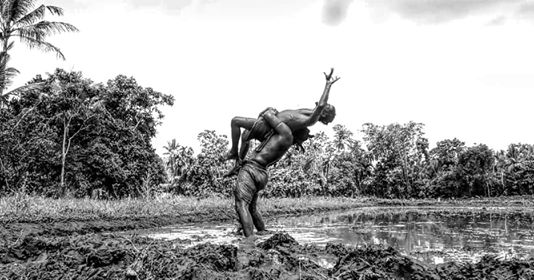
Angampora (Sri Lanka)
- Name of sport (game): Angam, Angampora
- Name in native language: Angam, also known as angampora, Sinhala: අංගම්පොර
- Place of practice (continent, state, nation):
Sri Lanka
Angam is practiced widely in western, Southern and Sabaragamuwa provinces in Sri Lanka. - History:
Angam is believed to have been a part of the ancient culture of Sri Lanka that dates back to over 5000 years. It had evolved from generation to generation, standing the formidable test of time, and once became an indispensable part of the Sri Lankan way of life.
For centuries the country went through most turbulent eras that required it’s rulers to muster defenses with the help of their fellow countrymen, to battle invasions that came from foreign lands as well as dissension from within.
The monarchy maintained a reasonable army that consisted of full time soldiers, but the majority of countrymen were ready to answer the call to arms in the name of king and country. Hence Masters of Angam were scattered throughout the land under whom civilians who engaged in different trade such as farming, pottery etc… also trained in the martial arts for mental and physical discipline as much as to be able to protect their country in a time of need.
Because of its fierce nature the British rule of Sri Lanka at the time banned and outlawed the practice of Angam and resorted to extreme measures which included imprisonment, persecution, and an order to shoot in the knees of any known practitioner of the art during the colonial era of Sri Lanka by the British as it fueled the martial spirit of the natives. Due to this situation, Angam was practiced solely underground among a select few. Most Gurus (masters) refrained from teaching, but a few warrior families that were dedicated for the preservation of the art, carried it through generation to generation until today.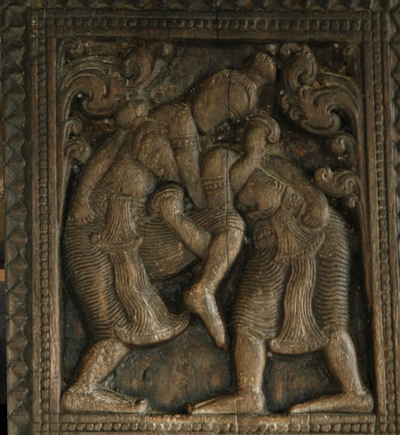 Historical Ambekke Gal Ketayam
Historical Ambekke Gal KetayamThe history of angam is unclear and fragmented, due to the fact that it’s vast history and evolution to what it is today, had never been recorded in an official treatise. However it is fortunate that the technical aspects of angam had been documented by angam warrior clans of Sri Lankan. All we have are inconsistent records of instances in history where it has appeared but briefly, only to disappear from the books of history leaving gaps as well as a lot of unanswered questions.
Angam is believed to have been a part of the ancient culture of Sri Lanka that dates back to over 5000 years. It had evolved from generation to generation, standing the formidable test of time, and once was an indispensable part of the Sri Lankan way of life.
For centuries the country went through most turbulent eras that required it’s rulers to muster defenses with the help of their fellow countrymen, to battle disturbances that came from foreign lands as well as dissension from within.
The monarchy maintained a reasonable army that consisted of full time soldiers, but the majority of countrymen were ready to answer the call to arms in the name of king and country. Hence Masters of Angam were scattered throughout the land under whom civilians who engaged in different trade such as farming, pottery etc… also trained in the martial arts for mental and physical discipline as much as to be able to protect their country in a time of need. Out of these schools several managed to be outstanding and make the books of history.
The earliest indication of Angam is believed to have been inherited through the vast knowledge of King Ravana who believed to have ruled over ancient Sri Lanka some 6000 years ago. One of the more recent indications of the art stems from the war torn legend of king Dutugamunu who reign in 161 BC. King Dutugamunu was believed to have had Ten Great Warriors who have impressive tales woven around their fearless exploits with their king, were believed to have been experts of Angam. Moreover, the king himself is believed to have been an expert in the art, and had been a warrior king in the front line of the battle that ensued the liberation of “Pihit Rata” region of Sri Lanka.
With the end of the Anuradhapura kingdom in 1017, it spelled the end of ancient Sri lanka and the beginning of the medieval timed period. Throughout this time there are only sketchy references to kings and warriors who have displayed skills in the art.
Later with the beginning of Colonial Sri Lanka that ensued after the visit of Lourenço de Almeida in 1505, its citizens were once again called to arms to defend their country against foreign invasions. With the increased activities of the portages e invaders, 16th century Sri Lanka faced more turbulent times. During this era, history boasts of many endeavors of Sri Lankan warriors who defended their territories through savvy war tactics such as guerilla warfare and the use of varied weaponry.
The fabled battle of mulleriyawa in 1562 stands testament how Angam became an invaluable weapon to fend off invaders at the hands of heroic Sri Lankan warriors. After years of insurgency, the foreign invaders managed to divide and conquer the island through trickery. This spelled fatal to the Sri Lankan martial art world, as its new foreign rulers, the appointed governor of Ceylon Robert Brownrigg banned and outlawed the practice of Agam. Extreme measures were taken that included imprisonment, persecution, and an order to shoot in the knees of any known practitioner of the art.
In the outset of such times, many (gurus) masters of the art, along with its avid practitioners went underground, and employed various methods of concealing the art in plain sight. One such attempt was within the rhythmic movements of Sri Lankan Traditional dance, where hidden within the graceful bend of a knee or the flip of a hand was a deadly and effective technique of Angam.
During it’s more prevalent years, Angam was taught by two main schools namely Sudaliya and Maruwalliya, and history speaks of a long standing rivalry between the two clans. Be that as it may this was on of the very few known fact of angam. Besides that there were clans such at Kotte Clan, Ritigala Clan, Warnasuriya Clan, Padiwita Clan, and many more clans who has taken after the names of families and region where the art was well preserved with its true form and purity.The Ravana Age 2554 – 2517 BC.
The age of King Ravana is considered to be the time when the art of Angam was at its pinnacle. Ravana was said to be a specialist in pressure point healing. This is evident in the medical writings done by Ravana. The association between Ravana and Angam is so strong, it is such that even today, Angam gurus begin their training only after lighting a lamp in memory of this ancient Sri Lankan King. The art of Angam which was developed for so many thousands of years has done its best in protecting Sri Lanka from its enemies.
Venerable Kirielle Gnanawimala thero, a writer and scholar, explains this about King Ravana. “It is possible to conclude that the Sri Lankan King Ravana mentioned in the legendary Indian epic ‘Ramayana’, was not a fictional character but an actual historical figure. The “Ravana Kitte” area which is not submerged by the sea and other places such as Ravana falls, Sita eliya, by investigations, implies this and also it is possible to know that King Ravana’s tomb was made in the shape of a pyramid analogous to the pyramids of Giza.”
Ravana is said to have also been a specialist in all forms of Angam. History tells us that he has written several books about it as well. This master in Angam is said to have trained all his soldiers, cavalry and other types of mounted troops in the art of Angam.
According to the historical notes in the “Rajawaliya”, the reign of King Ravana was during 19th century BC, which is the period between 2554-2517, to be precise. The cause for King Ravana’s untimely death is said to be due to a betrayal, a very common occurrence in the history of monarchs in Sri Lanka.
History tells us that, prince “Vibhishana”, Ravana’s younger half-brother, has conspired with Rama, the exiled north Indian prince in order to have the throne of Lanka for himself. Vibishana has known what is said to be the only way to kill Ravana, and had shared this knowledge with Rama. Yet, the popular Indian version of the story tells us that Rama conspired with Vibhishana to kill Ravana because he kidnapped Rama’s wife, Sita.
There are north Indian folk tales and legends that also explains how Ravana trained Rama’s younger brother Lakshmana of the art of Angam, before the war with Rama. Even though Ravana had known Lakshmana was his enemy, he had done so out of pure compassion towards the boy.
Ravana is also said to have ruled over many states in southern and central India. To maintain such a large empire, it is obvious that the aid of something as formidable as Angampora was essential.
Even now, after all these ages, certain families still have deadly Angam fighting styles names after Ravana, which specifically use pressure points to disable and eliminate ones opponents.
Source: https://www.angampora.com/angampora/ - Description:
The combat techniques of Angampora include locks and grips, strikes and blocks, and most especially pressure point attacks that can cause pain or even permanent paralysis. There are also self-defense techniques, sport, exercise and meditation techniques which can be learned. It is believed that there was also a some secretive Angampora techniques known as ‘maya angam’ that used incantations and spells for attack.
Angampora Training
• A practice session in Angampora begins with meditation and offering of merit to the master.
• The student then lights three lamps before he entered the training hut.
• Pledges have to be made promising to use the technique solely for purposes of self-defense and the defense of family or country.
• Actual practice begins with basic warm-up exercises, gradually moving on to special exercises.
• Foot movement techniques are the cornerstone of Angampora; and a foot exercise named ‘mulla panina’ is the first skill taught. This exercise is followed by more advanced techniques.
• Weaponless combat known as amaraya is taught next and the student learns to observe and attack the weak points of an opponent.
• The subsequent area of training is in weaponed combat. In total, there are sixty-four types of weapons; including thirty-two sword variants and several traditional weapons.
• Some of the deadly, higher-level Angam attacks that trainees learn involve the nervous system; while others if executed properly, can halt the blood flow to vital organs leading to paralysis or even death.
• Alongside such techniques students also learn an indigenous medical practice known as beheth pārawal (medical shots) which reverses the effects of such strikes.
• Finally on mastering all these the fighter receives a graduation ceremony at a Buddhist Temple.
• However, they can continue to train to become fencing masters or Pannikiralas; which is the highest position in Angampora.
Source: https://lakpura.com/angamporaAccording to the contemporary experts in Angampora history, there have been six subject areas related to Angampora Education.
They are:
Angampora (Unarmed combat), Ilangampora (Armed combat), Maya Angam (Black and white magic), the Art of Dancing and Drumming, Herbal Medicine and Astrology.
Over the span of time, some of these areas have been lost but the most parts of it have been preserved well by the passionate masters.
The term Angampora refers to physical combat, and is essentially the martial use of limbs, but no weapons. It's categorized into three types; Pora Haramba (offensive and defensive techniques), Gataputtu (grips and locks) and Maru Kala (Vital point attacks).
Pora Haramba has eighteen offensive strikes that can do serious damages to the opponent, and seven defensive techniques to avoid punches from the opponent. Dik gutiya, Athul pahara, Piti pahara are some of the popular offensive techniques in Angampora.
In order to disarm the enemy, make him weak or to kill, the Gataputtu strategy is used. This includes putting grips, locks on opponent’s body parts like hands, legs, and head etc. Diyaballu Gataya, Kathira Gataya, Pimburu Gataya, and Wanda Gataya are few of the many Gataputtu methods. A proper Angampora warrior should know all these, as well as the techniques to redeem from them.
Maru Kala is the most important technique in Angampora. It is advanced and not everyone gets the opportunity to learn it, as this subject includes the study of crucial nerve point strikes. Such strikes require a certain amount of power and speed, and a fighter who is excelled at Maru Kala can cause great pain to the opponent, make him paralysed, incompetent, swoon or give a quick death.
Therefore, a few selected people who are trustworthy can study this, and they should swear a special oath by the name of Lord Buddha and Maha Ravana to not to use these techniques against anyone, unless it’s absolutely necessary. They also can’t teach Maru Kala to anyone with low qualities.
Ilangampora, the art of armed combat is consisting thirty two weapons (Dethis Ayudha) and divided into four main categories; Curved weapons, Circular weapons, Long weapons, and Blunt weapons.
An Angampora student should at least practice for two years before they learn Ilangampora, as it requires a great dedication and discipline.
During that training period trainees got to practice with wooden swords at baby coconut trees, or banana trees. The archery training is done using targets drawn on trees, and swinging coconuts.
Source: https://www.yamu.lk/blog/angampora-the-ancient-martial-art-of-sri-lanka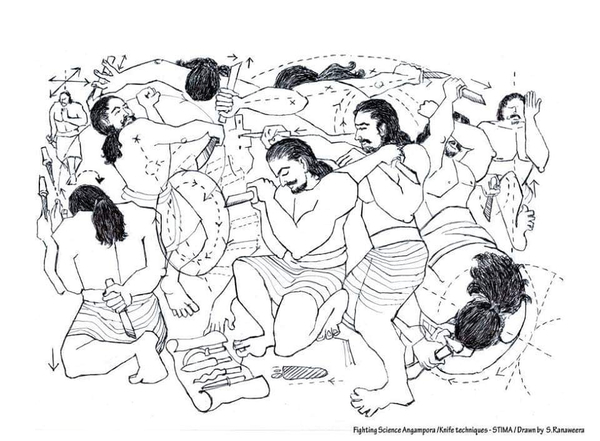 Source: Sri Lankan Traditional Indigenous Martial Art Association
Source: Sri Lankan Traditional Indigenous Martial Art Association
Angam contains six different components, namely;
1. අංගම්ප ොර (unarmed combat)
2. ඉලංගම්ප ොර (armed combat)
3. මායාඅංගම් (black magic & white magic)
4. නැටුම්හාපෙරවාදන (dancing & drumming)
5. පේහධම්මපේශියවවදයක ර්මය (herbal medicine)
6. පයොතිෂ්යවිදයාව (astrology)
Of the six components, Illangampora occupies a special position as it involves the use of arms for combat, and mastery in that art is considered to be essential to become a competent Angam practitioner. A student is required to complete two years of training in other aspects of angam, before starting to learn the art of illangam. Thirtytwo types of weapons, known in the Sinhala language as Dethis-ayudha( “පදතිස්ආයුධ”)are used in Illangam. The 32 weapons are categorized as follows;
1. වක්ආයුධ– Curved weapons
2. වක ්්රආයුධ– Circular weapons
3. දික්ආයුධ– Long weapons
4. පමොට්ටආයුධ- Blunt weapons
5. කංචආයුධ –Kuncha
Source: http://www.natlib.lk/pdf/angampora.pdfElangampora is another special part of Angam. This is known as the armed combat techniques of Angam. To be complete and competent Angam practitioner, the knowledge of Elangam is essential. Normally Elangam is taught to a student after at least two years into his Angampora (unarmed) training. Learning this requires a lot of discipline and dedication. Generally, students are taught the techniques pertaining to all weapons, one can only “master” two or three weapons according to one’s physical prowess. Most of the weapons used for practicing are cleansed with specialized rituals. A student must be granted permission from the guru in order to learn a particular weapon, and this is signified by performing a special ritual where the weapon is handed over to the student by the guru.
This art consists of 21 main weapons including 7 main weapons as follow:
1. Sword - The sword is the most revered weapon in the Elangam armory since ancient times. There are 32 types of swords used in ellangam. Ancient ellangam fighters were experts in wielding the single sword, double swords as well as the four bladed sword play. There are many variations to the sword such as long sword, short sword, wak kadu (curved sword), nai pena kadu (cobra head sword) . The shield was used in combination with the sword in ellangam.
2. Stick (long/short) - The long stick is one of the most important weapons in Elangam. Its length is usually measure up to the nose level of its wielder. It is made using “venivel” or cane sticks, and it is hardened using medicine oils and heating in fire. The main movement of the long stick comprises of the wielders ability to rotate it around one’s body with considerable speed and agility. Long stick comprises special foot movements and 16 basic strikes.
The short stick is an important weapon in the elangam armory. It has become popular because it is a weapon that can be fabricated or found easily. The basic practice of the short stick comprises 8 types of special foot movements and 12 basic strikes including joint locks and wrist locks.
3. Spear - Before learning the spear, the practitioner must become familiar with the techniques and stepping of stick play in angam. After the sword, the spear was the most used weapon in the ancient sri Lankan military. The spear is wielded as a single weapon as well as in combination with the shield.There three types of spears Long spear, Mid length spear, Short spear.
4. Dagger - The dagger is one of the main weapons in the Ellangam armory with single and dual dagger wielding techniques. The dagger is taught for self-defense and close quarter combat. In Angampora there are techniques to attack the upper and lower body. It addition to its martial applications, it also has aesthetically appealing techniques for display.
5. Special Weapons - It is recorded that there are more than 21 weapons variations in the ellangam armory. The most unique weapon among them is the “welayudha”. Apart from that Ang kinissa, Thun kinissa, Maradanda, maruwala, kalakirinyga and the kerchief are weapons for which special foot movement are practiced. Some of these weapons are unique to elangampora.
6. Battle axes - The axe was also a weapon that was a part of the day to day lives of the ancient Sri Lankan. Apart from being used as a tool it was used as a weapon and was normally wielded by individuals of superior strength. It can be dual wielded as well as used individually according to the history King Ravana’s brother Kummbakarna used battle axes as his choice of weapon.
7. Mace - Mainly used to attack the stronger parts of the body — head, thighs and ribs. The practice of Mace (gada) increases body strength. The Mace was used by a select few among the ranks of the ancient Sri Lankan military. Maintaining the balance and moving with the flow of the weapon are important in in Mace wielding. One special feature of the Mace is that a Mace can only be blocked by a Mace and it is difficult to be blocked using any other weapon.
Source: https://www.angampora.com/elangampora/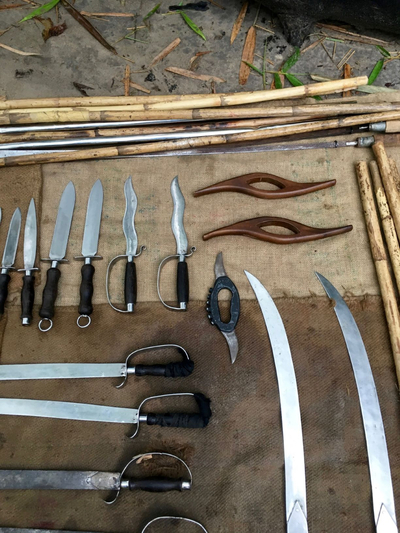
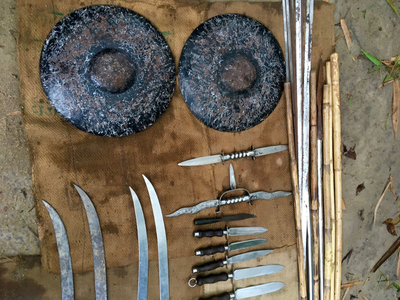
Photos: Sri Lankan Traditional Indigenous Martial Art Association
- Current status:
Angam is practiced by two main schools namely Sudaliya and Maruwalliya that are traced back into history as two rival clans. Apart from the two main schools, there are several smaller groups practicing the element. Among them, Kotte Clan, Ritigala Clan, Warnasuriya Clan, and Padiwita Clan are fairly well known. Additionally, there are few more groups who are called after the names of their families or villages.
- Contacts:
Sri Lankan Traditional Indigenous Martial Art Association
STIMA Main training center
202A, Moratuhena Road, Arthurugirya
Tel.: +94 77 383 8607
Webside: https://www.angampora.com/
E-mail:This email address is being protected from spambots. You need JavaScript enabled to view it.
Fb: https://www.facebook.com/traditionalangam
Youtube: https://www.youtube.com/angamporastima
Instagram: https://www.instagram.com/angampora/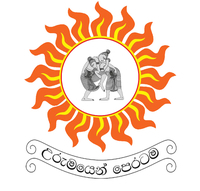
- Sources of information :
Books:
Liyanage, Bandula (2011), Angampora jayagath maraliya, Godage, Colombo.
Deshamanya Dr. Ajantha, Angampora - A Nation's Legacy In Pictures, Perera Hussein Publishing House, ISBN : 978-955-7844-00-8Articles:
http://exploresrilanka.lk/2010/07/angampora-the-martial-art-of-sri-lankan-kings/
https://www.cultural.gov.lk/web/index.php?option=com_content&view=article&id=67%3Athe-art-of-angam-fighting&catid=35%3Aright&Itemid=72&lang=en
http://www.island.lk/index.php?page_cat=article-details&page=article-details&code_title=31826
http://livingheritage.org/angampora.htm
https://www.behance.net/gallery/66960695/ANGAMPORA-The-Deadly-Ancient-Legacy-of-Sri-Lanka
https://www.yamu.lk/blog/angampora-the-ancient-martial-art-of-sri-lanka
https://www.colombotelegraph.com/index.php/angampora-5000-years-of-combat-tradition-a-response/
https://www.behance.net/gallery/14442209/Angampora-A-Photo-Essay
https://projectangampora.wordpress.com/2015/04/10/history-and-mystery/
https://www.talesofceylon.com/tales-of-ceylon/tales-of-angampora/angampora-sri-lankas-unique-art-of-combat/
http://www.jasonblackman.net/blog/angamporaVideo:
https://www.youtube.com/watch?v=eEduYCWEnIQ&feature=share&fbclid=IwAR1IGSR-SylsLGvFe-kXhjPSjy76Lcb8h15GLb9gEOkh6014qfdlfZIgtgA
https://www.youtube.com/watch?v=N9iwNHDNBjw
https://www.youtube.com/watch?v=EPA5-jlt9xU
https://www.youtube.com/watch?v=Jj0S4cc99N8
https://www.youtube.com/watch?v=J6a3DX121D0&feature=share&fbclid=IwAR2x809XxqozeNf22Oo9iEn9ylNxivyvFYFYX60NlmOJDxL2Dyo9HAuoRS0
https://www.youtube.com/watch?v=dSuc64-kcLc
https://www.youtube.com/watch?v=Jj0S4cc99N8&feature=emb_logo
https://www.youtube.com/watch?v=eEduYCWEnIQ&feature=emb_logo - Gallery:
- Documents:

